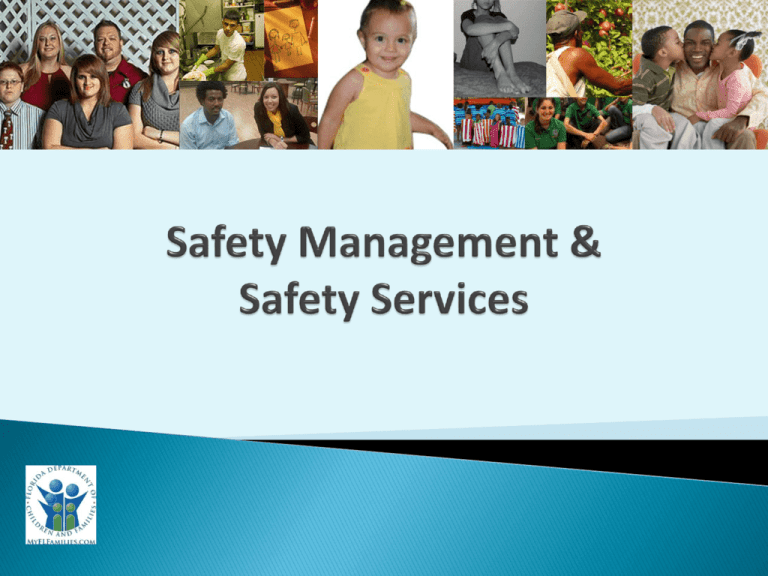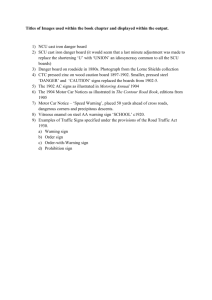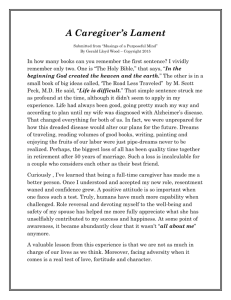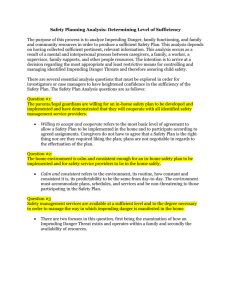Title of Presentation - Florida's Center for Child Welfare
advertisement

Context for the Training Training Related to Implementation of Safety Decision Making Methodology Fidelity ◦ Philosophy of practice ◦ Intervention purpose and framework ◦ Conceptual and criteria basis for practice and decision making ◦ Process, practice and outcomes 2 3 To understand the role, responsibilities, and collaboration necessary for ensuring the sufficiency of safety plans and supporting effective Safety Management To recognize what constitutes sufficient In-Home Safety Plans To develop a knowledge base related to the use of Safety Categories and Safety Services to control/manage Impending Danger To develop skills for providing and/or managing Safety Services 4 5 Inform training and development Provide feedback to trainer Measure change 6 Foundational Knowledge: Review of Methodology Initial Contact: Present Danger No Yes Information Collection Present Danger Plan Assess for Impending Danger No Safe Yes Unsafe In-Home Safety Analysis Investigation closed Family may be referred for services in community. In Home Out-ofHome/ Removal Develop Safety Plan 8 Child Protection Investigator Case Management • Safety • Safety • Danger Threats • Danger Threats • Caregiver Protective Capacities • Caregiver Protective Capacities • Present and Impending Danger Safety Plans • Present and Impending Danger Safety Plans • Safety Management • Case Plan/Treatment--Change 9 Safety Management and Enhancing Caregivers Protective Capacities Preparation Developing Strategy for Engagement Introduction Engagement Caregiver Protective Capacity Assessment Child Needs Exploration Determine What Must Change Through Information Collection Danger Statement Family Goal Motivation for Change Complete FFA-Ongoing Case Planning Develop Strategies for Change Case Plan Outcomes Case Plan 10 Engage Caregiver Protective Capacities and Child Needs FFAOngoing Raise Awareness Focus Treatment 11 Are danger threats being managed with a sufficient safety plan? How can existing protective capacities – STRENGTHS – be built upon to make changes? What is the relationship between danger threats and the diminished caregiver protective capacities—What must change? What is the parent’s perspective or awareness of his/her caregiver protective capacities? What are the child’s needs and how are the parents meeting or not meeting those needs? 12 What are the parents ready and willing to work on in the case plan to change their behavior? What are the areas of disagreement with the parent(s) as to what needs to change? What change strategy will be used to address the diminished protective capacities? 13 Safety is paramount and the basis for intervention! Case planning process and interventions can be more clearly defined around the use of safety concepts and behavior change Case planning process can be structured in a way to encourage and direct parents’ involvement and establish consistent intervention decisions and objectives 14 Engagement Teaming Assessment/Understanding Planning ◦ Safety Plan ◦ Case Plan Tracking and Adapting ◦ Safety Plan Sufficiency Evaluation & Update ◦ Case Plan Progress Evaluation & Update 15 16 Overview of Safety Management Roles and Responsibilities Contribute to effective safety planning Collaborate on establishing sufficient in-home and out-ofhome safety plans Assist with implementing in-home and out-of-home safety plans Manage in-home and out-of-home safety plans upon case transfer Modify safety plans based upon changes in family circumstances/conditions and caregiver protective capacities Facilitate conditions for return 18 #1: To participate effectively in the safety planning process which occurs at different stages of intervention. Safety plan establishment (led by CPI), including visitation plan if out of home Case transfer staffing (formal handoff of safety management responsibilities) Safety plan reconsideration as CBC assumes case management responsibility In-home safety plan establishment as step-down from out-ofhome safety plan 19 #2: To manage impending danger as specified in the safety plan. Observe safety providers in action (formal and informal) Confirm schedules of providers in advance and following service provision Observe, inquire about caregiver behavior in the home which was contributing to the impending danger (is the plan working?) Confirm visitation safety (sufficiency of supervised or unsupervised visitation) 20 #3: To effectively manage, perform and coordinate safety services as set forth in the safety plan Engage caregivers to participate with and support in-home safety services Case manager may have role to perform in actually carrying out a safety plan Management of the visitation plan established, assuring continued attention to safety (supervised or unsupervised) 21 #4: To facilitate overall case management and safety management to support the family toward meeting the conditions for return (for out-of-home safety plans) Contribute to establishing the conditions for return Understand and effectively explain the conditions for return to family members Engage caregivers in efforts to work toward meeting the conditions for return Provide direct support and continued encouragement to family to meet the conditions for return 22 Management by objectives works if you first think through your objectives. Ninety percent of the time this doesn’t occur. Peter Drucker, Social Ecologist 23 Controlling Intervention Provisional/Conditional Action oriented Dynamic Organized Proactive Directed Regulated 24 Florida’s Service Array Family Support Services Safety Management Services Treatment Services Child Well-Being Services Florida’s Service Array Safe Low/Moderate Risk Family Support Services delivered through community referrals to aid families with resource needs with no required case coordination. These cases may be captured in the Family Support Module in FSFN. Safe High/Very High Risk Family Support Services with case coordination throughout the life of the case targeted at building a families’ protective factors at a macro level and address barriers to long term safety . These cases must be captured in the Family Support Module in FSFN. Unsafe In-home Non-Judicial Unsafe Unsafe Out-of-Home In-home Non-Judicial Judicial Unsafe Out-of-home Judicial Require Safety Management Services that immediately take effect/action to protect the child from the identified danger threat(s) until the diminished caregiver protective capacities can be enhanced and demonstrated over time. Utilize Treatment Services to enhance diminished Caregiver Protective Capacities within the context of a danger threat(s) to achieve long term behavior change ultimately mitigating the need for a safety plan/ safety services Utilize Well-Being Services to enhance certain desired conditions in the life of the child that are directly related to child strength and needs indicators. Family Support Services Voluntary supportive family Services to prevent future child maltreatment among at-risk families. Safety Management Services Treatment Services Treatment Services are specific, usually formal, services/interventions Safety Services are to achieve fundamental actions, activities, tasks, change in functioning or imposed situations that and behavior associated may be formal or informal with the reason that the and are provided by child is unsafe. professionals and nonprofessionals for the purpose of managing or controlling Impending danger threats and documented in a safety plan. Safety Services must be capable of having an immediate effect, must be immediately available, must always be accessible, and must be sufficient to control Impending Danger. Safety Services are grouped according to five objectives: behavior management; crisis management; social connection; separation; and resource support. Child Wellbeing Services Child well-being services are specific, usually formal, services/interventions utilized to assure the child’s physical, emotional, developmental, and educational needs are addressed. The assessment of the child strengths and needs indicators is used to systematically identify critical child well being needs that should be the focus of thoughtful, case plan interventions. Exercise: Hypothetical Scenario/Parallel Process 28 29 Safety Categories/Objectives and Safety Services Safety Categories refer to the objectives that are set forth in a Safety Plan specifically designed to manage Impending Danger: Behavior Management Crisis Management Social Connection Separation Resource Support 31 Specific action, activities, tasks, or imposed situations that are intended to achieve the objectives (Safety Categories) of a Safety Plan for managing or controlling Impending Danger. Immediate effect Immediately available Accessible as required Logical 32 Purpose: Sufficiently control the Impending Danger and ensure protection Safety Categories: Functional objectives of the Safety Plan to achieve purpose Safety Services: Actions, activities, etc. designated to achieve objectives 33 Identifying Safety Categories and Safety Services Based on Impending Danger 34 Module 9 35 Modifying Safety Plans Use of in-home, out-of-home, combination of actions Clarification of the role of parents (caregivers) in the plan Protective role of others Specification of the safety services from a limited to extensive perspective Use and responsibility of the family network and professionals Parent (caregiver) access to child Identification and rationale for different kinds of separation Anticipated time limits that govern separation 37 Must control or manage Impending Danger Must have an immediate effect Must be immediately accessible and available Must contain safety actions only No promissory commitments 38 39 Evaluating Conditions for Return • Reunifying a child with his family is based on caregivers meeting case plan outcomes. • A central thought on caregivers’ minds when CPS is involved is what is necessary to get their children returned to them and get the agency out of their lives. • Conditions for return are criteria for reunification and for the purpose of keeping kids safe at home with an in-home safety plan. • Child placement is the option agencies use when a safety plan will not work. • Child placement should be viewed as a temporary safety management response that is most intrusive. • Child placement is necessary until threats to a child’s safety are gone. • Caregivers deserve to know exactly what is required in order to get their children returned home. 41 • Impending Danger must be understood to determine sufficient safety management • Safety Planning Analysis and Conditions for Return logically correspond with how impending danger is occurring − Frequency − Intensity − Influences • Specific to caregiver willingness, acceptance, and capacity for in-home safety management • Understandable • Necessary and Allow for an in-home safety plan 43 • A written statement identifies specific circumstances that must exist within a child’s home to implement an in-home safety plan so that a child who is placed can be returned to his or her parents/caregivers. • What is necessary for children to be reunified with their family are circumstances which support “Yes” conclusions on the safety planning analysis questions required for an in-home safety plan: − Acceptable home environment residence/environment − Cooperative, willing and able caregivers − Sufficient in-home safety services resources 44 In small groups of 3 or 4: • Review written case information: Intakes, PDA, PDA Safety Plan, FFA, Impending Danger Safety Plan, FFA Ongoing • Complete the worksheets based upon the case material 45 Evaluation of progress toward conditions for return Evaluation of progress toward enhancing caregiver protective capacities to assure long term independent safety management 47 49 Interpersonal Skills for Providing In-Home Safety Services What is the best approach and the most effective way to interact with caregivers when providing Safety Services? 51 Empathy Genuineness Compassion Respect Motive 52 Characteristics of the Caregiver Discussion 53 Generalized Anger Aggressive Isolation and Loneliness Impulsive Insecurity Self-Centered/Narcissistic Low Empathy Tense Feeling Trapped Self-Critical Unloved Suspicious Indifference, Apathy Inflexible Inability to Handle Stress Unreasonable Developmental Disabilities Passive and Dependent Poor Life Management Immaturity Criminal Behavior/Record Diagnosed or Undiagnosed – Untreated Mental Illness 54 Unrealistic Life Expectations Fake Cooperation History of Employment Problems Seeks to Avoid People, Responsibility, Problem Solving Relationship Problems Outside the Home Critical Few Close Friends Aloof Superficial Relationships Lack of Motivation Distancing and Alienation from Others Anxiety Conflicted Relationships Depression Fear of Involvement Hopelessness Deceitful No Sign of Guilt or Conscience Manipulative Distorted Self Concept Temper Outbursts Misuse of Substances 55 “What people really need is a good listening to.” Mary Lou Casey – (Motivational Interviewing, 2nd Ed.) More than Physically Hearing. It Requires Discipline and the Right Attitude and Mind Set. 56 Ordering, directing, or commanding Warning, cautioning, or threatening Giving advice Persuading, arguing, or lecturing Moralizing; telling people how they should behave Judging or criticizing Labeling Over analyzing Questioning Withdrawing, distracting, changing the subject 57 LISTENING LEADING Attending Encouraging Paraphrasing Focusing Clarifying Questioning Perception Checking Reflecting Summarizing Informing Advising Confronting 58 Team Exercise and Competition 59 Inform training and development Provide feedback to trainer Measure change 60 Used for professional growth and development Updating/refining training material content and exercises Measure change 61 62






